Allen Tiller's Blog, page 31
July 23, 2018
Gawler's Hidden Secrets: "James Martin Memorial Statue"
Gawler's Hidden Secrets: "James Martin Memorial Statue"
<Transcript>
Remembered as “The Father of Gawler” James Martin’s Phoenix foundry on Calton Road produced railway locomotives, agricultural machinery and mining equipment. Established in 1848, the company soon became known as James Martin and Company Limited, and went on to employ 700 people in Gawler, making the town one of the most important industrial regions in South Australia of the time. Martin and Co Built 268 locomotives that were sent all over Australia.
James Martin also went into politics and served firstly as an Alderman on Gawler’s first council, and in 1861 Mayor of Gawler, a position he served in for 8 years. He also served as the Member for Parliament for the Barossa from 1865-1868 and a Member of the Legislative Council from 1885 until 1899.
James Martin was also a Freemason, serving as Master of the Lodge of Fidelity from 1860 until 1870. He was the President of Gawler Institute, of which he had donated the land for the building to be constructed on, the President of the Gawler AH&F Society, an elected member of the Gawler School of Mines Council, a Co-Trustee of the St Georges Church fund, Captain of Gawler Rifles and a member of the Gawler Race club, just to name a few of his associations with the towns various organistions.
A statue commemorates industrialist James Martin. The statue was originally located at the corner of Murray Street and Calton Road. A plaque detailing a brief history of James Martin was added to the statue in 1998.
After his death on December 24, 1899, a public meeting was held in Gawler in January 1900. It was decided a memorial fund would be created and that a memorial to Martin be established, in which it was voted that a Statue would be erected in his honour. The statue was carved by sculptor Gustave Henri Marchetti in Italy and is made from Carrara Marble, with a pedestal made from South Australian Granite. -it contains an inscription that reads: "James. Martin, 1821 -1899. A Public Tribute to His Worth."The statue was unveiled with much pomp and ceremony on the 15th August 1903 by Sir Samuel Way in its original position, adjacent to the Foundry Office of James Martin and Co on the corner of Calton road and Murray street.
In 2014 the statue underwent restoration, with a little cosmetic surgery to fix Mr Martins nose which had been broken off may years previously.It was relocated to its current position on Whitelaw Terrace on the 2nd of June 1969.
<End Transcript>
You can also find more of Allen’s work on his Blog and facebook on the links below: Blog: http://hauntedadelaide.blogspot.com/
Facebook:
https://www.facebook.com/TheHauntsOfAdelaide/?ref=bookmarks
https://www.facebook.com/AllenHauntingAustralia/
<Transcript>
Remembered as “The Father of Gawler” James Martin’s Phoenix foundry on Calton Road produced railway locomotives, agricultural machinery and mining equipment. Established in 1848, the company soon became known as James Martin and Company Limited, and went on to employ 700 people in Gawler, making the town one of the most important industrial regions in South Australia of the time. Martin and Co Built 268 locomotives that were sent all over Australia.
James Martin also went into politics and served firstly as an Alderman on Gawler’s first council, and in 1861 Mayor of Gawler, a position he served in for 8 years. He also served as the Member for Parliament for the Barossa from 1865-1868 and a Member of the Legislative Council from 1885 until 1899.
James Martin was also a Freemason, serving as Master of the Lodge of Fidelity from 1860 until 1870. He was the President of Gawler Institute, of which he had donated the land for the building to be constructed on, the President of the Gawler AH&F Society, an elected member of the Gawler School of Mines Council, a Co-Trustee of the St Georges Church fund, Captain of Gawler Rifles and a member of the Gawler Race club, just to name a few of his associations with the towns various organistions.
A statue commemorates industrialist James Martin. The statue was originally located at the corner of Murray Street and Calton Road. A plaque detailing a brief history of James Martin was added to the statue in 1998.
After his death on December 24, 1899, a public meeting was held in Gawler in January 1900. It was decided a memorial fund would be created and that a memorial to Martin be established, in which it was voted that a Statue would be erected in his honour. The statue was carved by sculptor Gustave Henri Marchetti in Italy and is made from Carrara Marble, with a pedestal made from South Australian Granite. -it contains an inscription that reads: "James. Martin, 1821 -1899. A Public Tribute to His Worth."The statue was unveiled with much pomp and ceremony on the 15th August 1903 by Sir Samuel Way in its original position, adjacent to the Foundry Office of James Martin and Co on the corner of Calton road and Murray street.
In 2014 the statue underwent restoration, with a little cosmetic surgery to fix Mr Martins nose which had been broken off may years previously.It was relocated to its current position on Whitelaw Terrace on the 2nd of June 1969.
<End Transcript>
You can also find more of Allen’s work on his Blog and facebook on the links below: Blog: http://hauntedadelaide.blogspot.com/
Facebook:
https://www.facebook.com/TheHauntsOfAdelaide/?ref=bookmarks
https://www.facebook.com/AllenHauntingAustralia/
Published on July 23, 2018 17:45
July 17, 2018
Beachport: Casualties of War
Beachport: Casualties of War
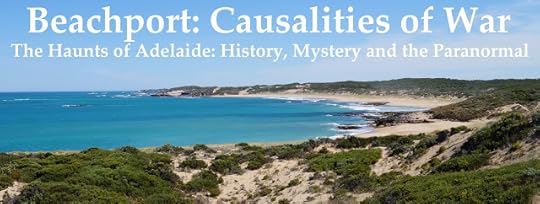
We think of you in silence.With a heart that is sincere.And cherish all the memoriesOf the days when you were here.
The 19th of February 1942, the Japanese bombed Darwin, the first attack on the Australian mainland by a foreign invader in a major global conflict. The two air raids on Darwin killed 235 people with a further 300 to 400 wounded.
7th months earlier, in the southern coastal town of Beachport, South Australia, two other deaths, directly associated with the war occurred on the 14th of July 1941. The deaths of Able Seaman W.L. Danswan and Seaman T.W. Todd of the Royal Australian Navy.
Sea mines, laid by the enemy, had begun to be found along the shipping routes of South Australia’s southern coast, with two sea mines found previously to this one. The mine was found 8 miles out at sea from Beachport, by local fisherman, Mr Stephens, who reported the find to the local constable.
The navy was called, and three men, Lieut. Commander Greening, Able Seaman Danswan and Seaman Todd were sent from Adelaide to defuse or detonate the 4ft diameter iron sea mine.
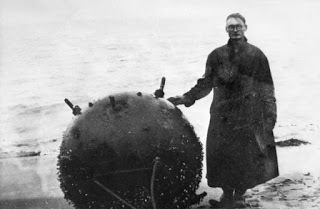 Photo: An unidentified man standing next to the enemy mine which exploded and killed Junee serviceman William Danswan, as well as Thomas Todd.(Source in Bibliography)The Navy men arrived in Beachport on Sunday the 13th, and with the help of four local fisher boats, headed out to sea to tow the mine back to the shore and examine it. On Monday the 14th the mine was pulled ashore at Beachport for dismantling, but instead, it was decided that it would be easier to blow it up, so the mine was pulled across the bay by a boat, and taken ashore near an old piling to be destroyed.
Photo: An unidentified man standing next to the enemy mine which exploded and killed Junee serviceman William Danswan, as well as Thomas Todd.(Source in Bibliography)The Navy men arrived in Beachport on Sunday the 13th, and with the help of four local fisher boats, headed out to sea to tow the mine back to the shore and examine it. On Monday the 14th the mine was pulled ashore at Beachport for dismantling, but instead, it was decided that it would be easier to blow it up, so the mine was pulled across the bay by a boat, and taken ashore near an old piling to be destroyed.
A demolition charge was connected to the mine, with a mile of cable ran out towards the cemetery, over a railway line, to ensure the safety of the 3 navy men. They pushed the plunger to detonate the mine, but it didn’t work, so a second line of cable was run out. This time, as the plunger was pushed, a passing railway truck disconnected the cable, and again the bomb did not explode.
The two Seamen waited 15 minutes, and made their way down to inspect the mine. They got within a few feet of it when it suddenly exploded, killing them almost instantly. Their Lieut. Commander, who had not descended the sand dunes, remained unharmed.
Many locals, standing on the local jetty and beach front witnessed the large explosion and death of the Seamen, and many more came out to see what was going on after hearing the concussive blast of the detonation.,
Able Seaman W.L.E. Danswan, who was from the town of Junee in New South Wales, was transferred from the H.M.A.S. Canberra to the Birkenhead Naval Base only 4 months previously. He left behind a widow.
Seaman T.W. Todd, who was from Rosewater, S.A. left behind a wife, Gwendoline Todd, and a young son, Ronald.
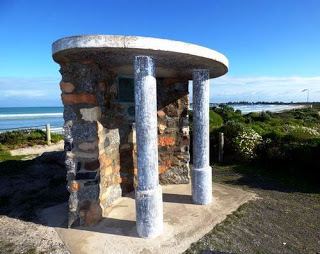
A monument to the men, the first two casualties on Australian soil of World War Two, stands at the eastern end of the surf beach carpark on the Millicent-Beachport road
© 2018 Allen Tiller
Like us on Facebook: https://www.facebook.com/TheHauntsOfAdelaide/www.allentiller.com.auwww.eidolonparanormal.com.au
Bibliography:
1941 'MILLICENT NEWS.', Southern Cross (Adelaide, SA : 1889 - 1954), 25 July, p. 6. , viewed 01 Jan 2018, http://nla.gov.au/nla.news-article167770740
1941 'MINE EXPLOSION AT BEACHPORT.', The South Eastern Times (Millicent, SA : 1906 - 1954), 18 July, p. 2. , viewed 01 Jan 2018, http://nla.gov.au/nla.news-article200099123
1941 'No Title', The South Eastern Times (Millicent, SA : 1906 - 1954), 22 July, p. 1. , viewed 01 Jan 2018, http://nla.gov.au/nla.news-article200099143
1949 'Family Notices', The Advertiser (Adelaide, SA : 1931 - 1954), 14 July, p. 14. , viewed 01 Jan 2018, http://nla.gov.au/nla.news-article36675976
National Archives of Australia, 2018, The bombing of Darwin – Fact sheet 195, National Archives of Australia, Australian Government, viewed 01 Jan 2018, http://www.naa.gov.au/collection/fact-sheets/fs195.aspx
Source: https://www.juneesoutherncross.com.au/story/4601686/junee-servicemans-tragic-wwii-demise-photos/#slide

We think of you in silence.With a heart that is sincere.And cherish all the memoriesOf the days when you were here.
The 19th of February 1942, the Japanese bombed Darwin, the first attack on the Australian mainland by a foreign invader in a major global conflict. The two air raids on Darwin killed 235 people with a further 300 to 400 wounded.
7th months earlier, in the southern coastal town of Beachport, South Australia, two other deaths, directly associated with the war occurred on the 14th of July 1941. The deaths of Able Seaman W.L. Danswan and Seaman T.W. Todd of the Royal Australian Navy.
Sea mines, laid by the enemy, had begun to be found along the shipping routes of South Australia’s southern coast, with two sea mines found previously to this one. The mine was found 8 miles out at sea from Beachport, by local fisherman, Mr Stephens, who reported the find to the local constable.
The navy was called, and three men, Lieut. Commander Greening, Able Seaman Danswan and Seaman Todd were sent from Adelaide to defuse or detonate the 4ft diameter iron sea mine.
 Photo: An unidentified man standing next to the enemy mine which exploded and killed Junee serviceman William Danswan, as well as Thomas Todd.(Source in Bibliography)The Navy men arrived in Beachport on Sunday the 13th, and with the help of four local fisher boats, headed out to sea to tow the mine back to the shore and examine it. On Monday the 14th the mine was pulled ashore at Beachport for dismantling, but instead, it was decided that it would be easier to blow it up, so the mine was pulled across the bay by a boat, and taken ashore near an old piling to be destroyed.
Photo: An unidentified man standing next to the enemy mine which exploded and killed Junee serviceman William Danswan, as well as Thomas Todd.(Source in Bibliography)The Navy men arrived in Beachport on Sunday the 13th, and with the help of four local fisher boats, headed out to sea to tow the mine back to the shore and examine it. On Monday the 14th the mine was pulled ashore at Beachport for dismantling, but instead, it was decided that it would be easier to blow it up, so the mine was pulled across the bay by a boat, and taken ashore near an old piling to be destroyed.A demolition charge was connected to the mine, with a mile of cable ran out towards the cemetery, over a railway line, to ensure the safety of the 3 navy men. They pushed the plunger to detonate the mine, but it didn’t work, so a second line of cable was run out. This time, as the plunger was pushed, a passing railway truck disconnected the cable, and again the bomb did not explode.
The two Seamen waited 15 minutes, and made their way down to inspect the mine. They got within a few feet of it when it suddenly exploded, killing them almost instantly. Their Lieut. Commander, who had not descended the sand dunes, remained unharmed.
Many locals, standing on the local jetty and beach front witnessed the large explosion and death of the Seamen, and many more came out to see what was going on after hearing the concussive blast of the detonation.,
Able Seaman W.L.E. Danswan, who was from the town of Junee in New South Wales, was transferred from the H.M.A.S. Canberra to the Birkenhead Naval Base only 4 months previously. He left behind a widow.
Seaman T.W. Todd, who was from Rosewater, S.A. left behind a wife, Gwendoline Todd, and a young son, Ronald.

A monument to the men, the first two casualties on Australian soil of World War Two, stands at the eastern end of the surf beach carpark on the Millicent-Beachport road
© 2018 Allen Tiller
Like us on Facebook: https://www.facebook.com/TheHauntsOfAdelaide/www.allentiller.com.auwww.eidolonparanormal.com.au
Bibliography:
1941 'MILLICENT NEWS.', Southern Cross (Adelaide, SA : 1889 - 1954), 25 July, p. 6. , viewed 01 Jan 2018, http://nla.gov.au/nla.news-article167770740
1941 'MINE EXPLOSION AT BEACHPORT.', The South Eastern Times (Millicent, SA : 1906 - 1954), 18 July, p. 2. , viewed 01 Jan 2018, http://nla.gov.au/nla.news-article200099123
1941 'No Title', The South Eastern Times (Millicent, SA : 1906 - 1954), 22 July, p. 1. , viewed 01 Jan 2018, http://nla.gov.au/nla.news-article200099143
1949 'Family Notices', The Advertiser (Adelaide, SA : 1931 - 1954), 14 July, p. 14. , viewed 01 Jan 2018, http://nla.gov.au/nla.news-article36675976
National Archives of Australia, 2018, The bombing of Darwin – Fact sheet 195, National Archives of Australia, Australian Government, viewed 01 Jan 2018, http://www.naa.gov.au/collection/fact-sheets/fs195.aspx
Source: https://www.juneesoutherncross.com.au/story/4601686/junee-servicemans-tragic-wwii-demise-photos/#slide
Published on July 17, 2018 01:17
July 10, 2018
Enfield Receiving House
Enfield Receiving House
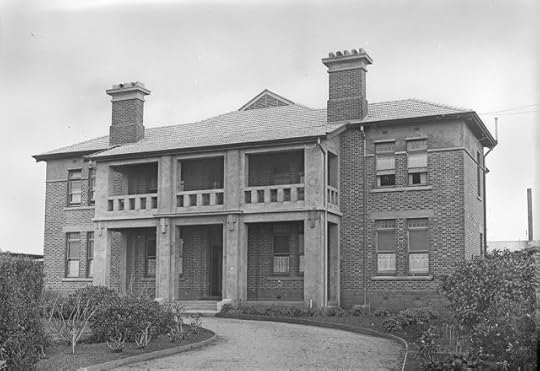 Enfield Receiving House circa 1926
Enfield Receiving House circa 1926
The Enfield Receiving House was an 80-bed facility built in 1922 to house South Australia’s mentally ill patients who were classified as “10th Schedule Admissions”. This hospital, and other mental health facilities in the State, came under the supervision of the Superintendent of Mental Institutions, Dr. H.M. Birch.
The Enfield Receiving House was situated on a 20-acre block at the corner of Grand Junction Rd, Foster's Rd and Hilltop Drive Adelaide, South Australia which remains vacant since its declassification in 1982 and subsequent demolition. A mental health facility still occupies some of the land where once sat the Northfield Security Hospital (1973 - 1987) for the criminally insane at the rear of where the Enfield Hospital once sat. That facility is James Nash House, built in 1987, which is a facility for ‘Forensic Mental Health’.
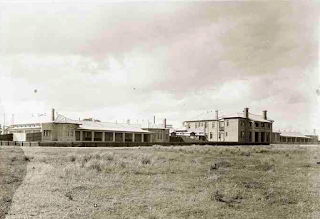 circa 1929Children were often housed with adults in the Enfield Receiving House. In 1935 a new Mental Defectives Act was passed that allowed the Minister to pass any person in a Government run facility, such as a gaol or reformatory, into a hospital for mental defectives. This meant that “criminal mental defectives” and children with intellectual disabilities could be housed in the same facility, and some confined to the same wards!
circa 1929Children were often housed with adults in the Enfield Receiving House. In 1935 a new Mental Defectives Act was passed that allowed the Minister to pass any person in a Government run facility, such as a gaol or reformatory, into a hospital for mental defectives. This meant that “criminal mental defectives” and children with intellectual disabilities could be housed in the same facility, and some confined to the same wards!
The Enfield Receiving House had its name changed in 1963 to the Enfield Hospital, but still acted in the same capacity, receiving those with intellectual disabilities and mental health problems, taking in both children and adults.
The difference between a Receiving Hospital and a Mental Hospital was a legal definition, that a Receiving Hospital is a temporary or observational treatment facility versus a Mental Hospital which is a facility for a more permanent patient stay.
Under old laws a patient could be admitted to a receiving house under a justice's order (s.32) and could legally be held (against their will) for 30 days, or if admitted on request (s.35), for two months.
These periods could be extended by new court proceedings, but only for a total of six months.
Committal to a mental hospital, such as Hillcrest or Glenside was seen as a more permanent form of institutionalisation and was governed by different laws, however, many patients from receiving homes ended up in these facilities.
Disturbing for some readers, is a book titled “The Last of the Lunatics”, written by former director of the Enfield Receiving house, between 1951 and 1963, John Cawte AO, MB BS, MD, DPM, PhD, FRANZCP, FRCPsych, FAPA.
In his book Cawte describes many aspects of his time at the hospital, often referring to specific cases taken from his own files, which survived the demolition of the hospital in 1982.
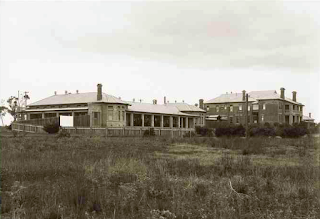 Cawte describes the use of continuous water baths, straight-jackets and padded cells, but perhaps most disturbing is his candid descriptions of electroconvulsive therapy and surgical lobotomies, or the use of insulin to produce comas in patients (sometimes known as ICT – insulin coma therapy or IST – Insulin shock therapy).
Cawte describes the use of continuous water baths, straight-jackets and padded cells, but perhaps most disturbing is his candid descriptions of electroconvulsive therapy and surgical lobotomies, or the use of insulin to produce comas in patients (sometimes known as ICT – insulin coma therapy or IST – Insulin shock therapy).
In 1979, The Enfield Hospital became part of the Hillcrest Hospital, and by 1982 was fully incorporated as part of the Hillcrest facility. Hill crest Hospital was decommissioned in 1994 and parts of the site sold off.
One part that remained, was Makk and McLeay and Clements House, three wards of the Oakden Older Person’s Mental Health Service, which was closed in 2017 after allegations of mistreatment by staff of its patients.
Researched and written by Allen Tiller © 2018
https://www.facebook.com/TheHauntsOfA...
References.
Cawte, John, 1998, The Last of the Lunatics, Melbourne University Press; Melbourne (Australia)
George, T. S. 1972, “COMMITMENT AND DISCHARGE OF THE MENTALLY ILL IN SOUTH AUSTRALIA”, The Adelaide Law Review, Iss.4, p. 331 viewed 2 July 2018, http://www.austlii.edu.au/au/journals...
State Records of South Australia, 'Agency Details: GA1993 Enfield Receiving House, later Enfield Hospital 1922 - 1981', in State Records of South Australia, ArchivesSearch, http://archives.sa.gov.au.
 Enfield Receiving House circa 1926
Enfield Receiving House circa 1926The Enfield Receiving House was an 80-bed facility built in 1922 to house South Australia’s mentally ill patients who were classified as “10th Schedule Admissions”. This hospital, and other mental health facilities in the State, came under the supervision of the Superintendent of Mental Institutions, Dr. H.M. Birch.
The Enfield Receiving House was situated on a 20-acre block at the corner of Grand Junction Rd, Foster's Rd and Hilltop Drive Adelaide, South Australia which remains vacant since its declassification in 1982 and subsequent demolition. A mental health facility still occupies some of the land where once sat the Northfield Security Hospital (1973 - 1987) for the criminally insane at the rear of where the Enfield Hospital once sat. That facility is James Nash House, built in 1987, which is a facility for ‘Forensic Mental Health’.
 circa 1929Children were often housed with adults in the Enfield Receiving House. In 1935 a new Mental Defectives Act was passed that allowed the Minister to pass any person in a Government run facility, such as a gaol or reformatory, into a hospital for mental defectives. This meant that “criminal mental defectives” and children with intellectual disabilities could be housed in the same facility, and some confined to the same wards!
circa 1929Children were often housed with adults in the Enfield Receiving House. In 1935 a new Mental Defectives Act was passed that allowed the Minister to pass any person in a Government run facility, such as a gaol or reformatory, into a hospital for mental defectives. This meant that “criminal mental defectives” and children with intellectual disabilities could be housed in the same facility, and some confined to the same wards!The Enfield Receiving House had its name changed in 1963 to the Enfield Hospital, but still acted in the same capacity, receiving those with intellectual disabilities and mental health problems, taking in both children and adults.
The difference between a Receiving Hospital and a Mental Hospital was a legal definition, that a Receiving Hospital is a temporary or observational treatment facility versus a Mental Hospital which is a facility for a more permanent patient stay.
Under old laws a patient could be admitted to a receiving house under a justice's order (s.32) and could legally be held (against their will) for 30 days, or if admitted on request (s.35), for two months.
These periods could be extended by new court proceedings, but only for a total of six months.
Committal to a mental hospital, such as Hillcrest or Glenside was seen as a more permanent form of institutionalisation and was governed by different laws, however, many patients from receiving homes ended up in these facilities.
Disturbing for some readers, is a book titled “The Last of the Lunatics”, written by former director of the Enfield Receiving house, between 1951 and 1963, John Cawte AO, MB BS, MD, DPM, PhD, FRANZCP, FRCPsych, FAPA.
In his book Cawte describes many aspects of his time at the hospital, often referring to specific cases taken from his own files, which survived the demolition of the hospital in 1982.
 Cawte describes the use of continuous water baths, straight-jackets and padded cells, but perhaps most disturbing is his candid descriptions of electroconvulsive therapy and surgical lobotomies, or the use of insulin to produce comas in patients (sometimes known as ICT – insulin coma therapy or IST – Insulin shock therapy).
Cawte describes the use of continuous water baths, straight-jackets and padded cells, but perhaps most disturbing is his candid descriptions of electroconvulsive therapy and surgical lobotomies, or the use of insulin to produce comas in patients (sometimes known as ICT – insulin coma therapy or IST – Insulin shock therapy).In 1979, The Enfield Hospital became part of the Hillcrest Hospital, and by 1982 was fully incorporated as part of the Hillcrest facility. Hill crest Hospital was decommissioned in 1994 and parts of the site sold off.
One part that remained, was Makk and McLeay and Clements House, three wards of the Oakden Older Person’s Mental Health Service, which was closed in 2017 after allegations of mistreatment by staff of its patients.
Researched and written by Allen Tiller © 2018
https://www.facebook.com/TheHauntsOfA...
References.
Cawte, John, 1998, The Last of the Lunatics, Melbourne University Press; Melbourne (Australia)
George, T. S. 1972, “COMMITMENT AND DISCHARGE OF THE MENTALLY ILL IN SOUTH AUSTRALIA”, The Adelaide Law Review, Iss.4, p. 331 viewed 2 July 2018, http://www.austlii.edu.au/au/journals...
State Records of South Australia, 'Agency Details: GA1993 Enfield Receiving House, later Enfield Hospital 1922 - 1981', in State Records of South Australia, ArchivesSearch, http://archives.sa.gov.au.
Published on July 10, 2018 02:22
July 3, 2018
The Adelaide Ghosts & Ghouls Walking Tour
The Adelaide Ghosts & Ghouls Walking Tour
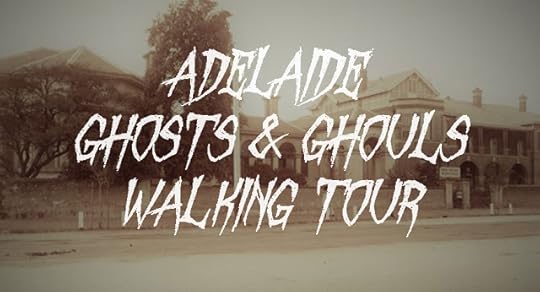
The Adelaide Ghosts and Ghouls Walking Tour explores the stories behind Adelaide’s alleged hauntings and crimes, while shedding light on some our city’s more chilling history. The tour is a collaboration between paranormal investigator Allen Tiller, sound recordist Anthony Frith, and Adelaide City Libraries. It was designed and developed based on research from Allen’s history residency at the libraries in 2016, along with a range of ghost stories brought forward via public consultation sessions.
You can download the tour here, and guide yourself any time of the day or night!
https://www.cityofadelaide.com.au/exp...
Follow on facebook:https://www.facebook.com/AdelaideGhosts/
 Tour locations
Tour locations
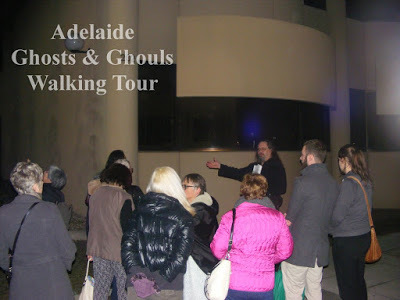 A surprise stop on the tour launch night, when Allen Tiller threw in an extra talk about the ghost that allegedly haunts the former channel 9 studios on Tynte Street
A surprise stop on the tour launch night, when Allen Tiller threw in an extra talk about the ghost that allegedly haunts the former channel 9 studios on Tynte Street
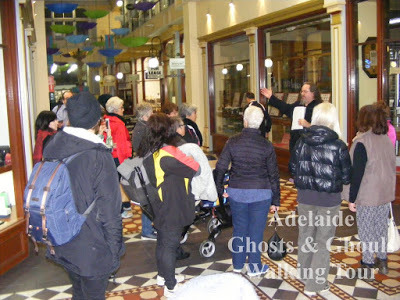 The Adelaide Arcade
The Adelaide Arcade
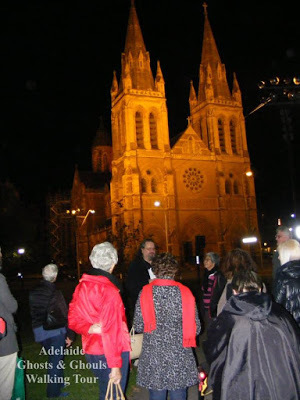 St Peter and Paul's Cathedral North Adelaide
St Peter and Paul's Cathedral North Adelaide

The Adelaide Ghosts and Ghouls Walking Tour explores the stories behind Adelaide’s alleged hauntings and crimes, while shedding light on some our city’s more chilling history. The tour is a collaboration between paranormal investigator Allen Tiller, sound recordist Anthony Frith, and Adelaide City Libraries. It was designed and developed based on research from Allen’s history residency at the libraries in 2016, along with a range of ghost stories brought forward via public consultation sessions.
You can download the tour here, and guide yourself any time of the day or night!
https://www.cityofadelaide.com.au/exp...
Follow on facebook:https://www.facebook.com/AdelaideGhosts/
 Tour locations
Tour locations A surprise stop on the tour launch night, when Allen Tiller threw in an extra talk about the ghost that allegedly haunts the former channel 9 studios on Tynte Street
A surprise stop on the tour launch night, when Allen Tiller threw in an extra talk about the ghost that allegedly haunts the former channel 9 studios on Tynte Street The Adelaide Arcade
The Adelaide Arcade St Peter and Paul's Cathedral North Adelaide
St Peter and Paul's Cathedral North Adelaide
Published on July 03, 2018 01:30
June 19, 2018
Victor Harbor UFO sighting 1974
Victor Harbor UFO sighting 1974
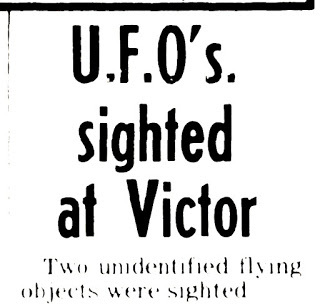
In May 1974 the skies of Victor Harbour on the Fleurieu Peninsula were visited by a mysterious unidentified flying object!
The UFO was witnessed by Mr Neville Dunn of Encounter Bay as well as two friends travelling from Bordertown.
Another witness to the event was First Class Constable Max Griffiths and his wife. The Griffiths witnessed two separate flashing lights travelling from east to west, not far the AMSCOL Cheese Factory (now the Lutheran Church).
The objects appeared from the north east at about 45 degrees in the sky. They eventually rose in the night sky, until one was no longer visible, and after twenty minutes, vanished from the night sky.
The authorities in the region later made a statement that a pilot in the area had radio problems and was forced to land at Murray Bridge. This explanation did not explain the second light seen by the Griffiths, nor the speed and angle of trajectory of the objects…
Did a UFO buzz Victor Harbor in 1974?
Have you seen a UFO in your area, let us know over on our facebook page, or in the comments section below.
© 2018 Allen Tiller
Like us on Facebook: https://www.facebook.com/TheHauntsOfAdelaide/
www.allentiller.com.au
www.eidolonparanormal.com.au

In May 1974 the skies of Victor Harbour on the Fleurieu Peninsula were visited by a mysterious unidentified flying object!
The UFO was witnessed by Mr Neville Dunn of Encounter Bay as well as two friends travelling from Bordertown.
Another witness to the event was First Class Constable Max Griffiths and his wife. The Griffiths witnessed two separate flashing lights travelling from east to west, not far the AMSCOL Cheese Factory (now the Lutheran Church).
The objects appeared from the north east at about 45 degrees in the sky. They eventually rose in the night sky, until one was no longer visible, and after twenty minutes, vanished from the night sky.
The authorities in the region later made a statement that a pilot in the area had radio problems and was forced to land at Murray Bridge. This explanation did not explain the second light seen by the Griffiths, nor the speed and angle of trajectory of the objects…
Did a UFO buzz Victor Harbor in 1974?
Have you seen a UFO in your area, let us know over on our facebook page, or in the comments section below.
© 2018 Allen Tiller
Like us on Facebook: https://www.facebook.com/TheHauntsOfAdelaide/
www.allentiller.com.au
www.eidolonparanormal.com.au
Published on June 19, 2018 03:00
June 12, 2018
Cathedral Hotel: Wrong Side of the Law
Cathedral Hotel: Wrong Side of the Law
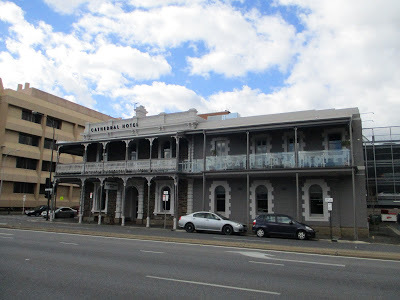 The Cathedral Hotel North Adelaide
The Cathedral Hotel North Adelaide
Photo: © 2017 - Allen Tiller
After two robberies in North Adelaide, and a number of other smaller thefts, suspicions were being raised within the North Adelaide Police station of whom the offenders might be.During the investigation of the Cathedral Hotel robbery, which netted the criminals a substantial amount of liquor and money, a time line of events was established.
The local tram night watchman was called in as a witness, and told the police on the night in questions, he had seen Constable Edwards, at about 2am, walking his beat, and test the barroom doors to see if they were locked. He also stated, after Edwards had long passed, he noticed lights on in the billiard room.
Constable Edwards confirmed that he had tried the doors during his nightly walk at about, what he though was 1:30 to 1:45 am, and the doors were locked, with no-one else around. The detectives investigating the recent crimes, now had a suspect, based on rumours they had heard, but more significantly, on the approximate time. The Detectives, Martin, Nation, Dedman and Goldsworthy drove out to Prospect to the house of Constable George Wyatt.George Wyatt, a police officer of seven years, married with three children, answered the door, and allowed the detectives in. He then allowed them to search his property, where they found a few bottles of alcohol, one of which had been hand written on by Mr Opie. Also in Wyatts possession were a number of tools, barbed wire and other goods, that Wyatt could not reasonably recount where he purchased them from.
Wyatt was arrested and taken to his own precinct, The North Adelaide Police station for questioning. Wyatt refused to give up his accomplice, stating “I am mongrel enough for what I have done, but I can't settle one of my own mates."
The Police began to look at who Wyatts mates were, and settled upon searching the house of friend, and fellow officer of 7 years, Constable John Farrar.
Farrar was found with a sum of money, and some of the missing bottle of alcohol. He was questioned and told his fellow officers Wyatt had given him the money and goods. When asked if he knew where they came from, he stated he did, but only after the fact.
The two police officers were formally charged, Wyatt with burglary and larceny, break and enter, and Farrar with receiving stolen goods.
Wyatt was sentenced to four years hard labour at and Farrar with three years of hard labour, both at Yatala prison, amongst some of the prisoners, they had probably arrested!
Both men’s descriptions were printed in the South Australia Police Gazette.
John Farrar: John Farrar, tried at Supreme Court, Adelaide, on November 4th, 1918, for receiving stolen property; sentenced to three years with hard labour ; and at Adelaide, on November 11th, 1918, for unlawful possession; sentenced to 12 months with hard labour; native of England, labourer, born 1882, 5ft 11.5 inch high, dark complexion, dark hair, dark-brown eyes (lowering eyebrows) medium nose (risen on point) medium mouth, broad chin, scar on left elbow and outside forearm, very hairy on cheat and back, remains of tattoo on left wrist, black spot on centre of back, Freedom due July 14th, 1920. [1]
George Wyatt: George Henry Wyatt, tried at Supreme Court, Adelaide on Nov 4th, 1918 for burglary and larceny, sentenced to four years hard labour, native of England, cooper, born 1887, 5ft 11in height.
Fair complexion, ginger colour hair, blue eyes, large nose, medium mouth, large chin, small ears (projecting), boil mark on back of neck, two small scars on right knee and one on shin, small scar on left knee. Discharged in February 1921.Researched and written by Allen Tiller ©2018Like us on Facebook: https://www.facebook.com/TheHauntsOfAdelaide/ www.allentiller.com.au www.eidolonparanormal.com.au
BibliographyThe Advertiser, Thursday 17 October 1918, p71918 'In the Courts. CRIMINAL.', Observer (Adelaide, SA : 1905 - 1931), 16 November, p. 13. , viewed 29 Jan 2018, http://nla.gov.au/nla.news-article164166616
1918 'Burglary at North Adelaide.', Yorke's Peninsula Advertiser (SA : 1878 - 1922), 11 October, p. 3. , viewed 29 Jan 2018, http://nla.gov.au/nla.news-article216349077
1918 'Sensational Arrests.', Port Pirie Recorder (SA : 1918 - 1919), 11 October, p. 2. , viewed 29 Jan 2018, http://nla.gov.au/nla.news-article95422823
1918 'Latest Telegrams', The South Eastern Times (Millicent, SA : 1906 - 1954), 11 October, p. 3. , viewed 29 Jan 2018, http://nla.gov.au/nla.news-article200047162
1918 'BURGLARS AT NORTH ADELAIDE.', The Mail (Adelaide, SA : 1912 - 1954), 5 October, p. 2. , viewed 29 Jan 2018, http://nla.gov.au/nla.news-article63753531
1918 'Late Telegrams.', Eyre's Peninsula Tribune (Cowell, SA : 1910 - 1950), 11 October, p. 2. , viewed 29 Jan 2018, http://nla.gov.au/nla.news-article219277618
1918 'COMMITTED FOR TRIAL.', Port Pirie Recorder (SA : 1918 - 1919), 19 October, p. 3. , viewed 29 Jan 2018, http://nla.gov.au/nla.news-article954...
 The Cathedral Hotel North Adelaide
The Cathedral Hotel North AdelaidePhoto: © 2017 - Allen Tiller
After two robberies in North Adelaide, and a number of other smaller thefts, suspicions were being raised within the North Adelaide Police station of whom the offenders might be.During the investigation of the Cathedral Hotel robbery, which netted the criminals a substantial amount of liquor and money, a time line of events was established.
The local tram night watchman was called in as a witness, and told the police on the night in questions, he had seen Constable Edwards, at about 2am, walking his beat, and test the barroom doors to see if they were locked. He also stated, after Edwards had long passed, he noticed lights on in the billiard room.
Constable Edwards confirmed that he had tried the doors during his nightly walk at about, what he though was 1:30 to 1:45 am, and the doors were locked, with no-one else around. The detectives investigating the recent crimes, now had a suspect, based on rumours they had heard, but more significantly, on the approximate time. The Detectives, Martin, Nation, Dedman and Goldsworthy drove out to Prospect to the house of Constable George Wyatt.George Wyatt, a police officer of seven years, married with three children, answered the door, and allowed the detectives in. He then allowed them to search his property, where they found a few bottles of alcohol, one of which had been hand written on by Mr Opie. Also in Wyatts possession were a number of tools, barbed wire and other goods, that Wyatt could not reasonably recount where he purchased them from.
Wyatt was arrested and taken to his own precinct, The North Adelaide Police station for questioning. Wyatt refused to give up his accomplice, stating “I am mongrel enough for what I have done, but I can't settle one of my own mates."
The Police began to look at who Wyatts mates were, and settled upon searching the house of friend, and fellow officer of 7 years, Constable John Farrar.
Farrar was found with a sum of money, and some of the missing bottle of alcohol. He was questioned and told his fellow officers Wyatt had given him the money and goods. When asked if he knew where they came from, he stated he did, but only after the fact.
The two police officers were formally charged, Wyatt with burglary and larceny, break and enter, and Farrar with receiving stolen goods.
Wyatt was sentenced to four years hard labour at and Farrar with three years of hard labour, both at Yatala prison, amongst some of the prisoners, they had probably arrested!
Both men’s descriptions were printed in the South Australia Police Gazette.
John Farrar: John Farrar, tried at Supreme Court, Adelaide, on November 4th, 1918, for receiving stolen property; sentenced to three years with hard labour ; and at Adelaide, on November 11th, 1918, for unlawful possession; sentenced to 12 months with hard labour; native of England, labourer, born 1882, 5ft 11.5 inch high, dark complexion, dark hair, dark-brown eyes (lowering eyebrows) medium nose (risen on point) medium mouth, broad chin, scar on left elbow and outside forearm, very hairy on cheat and back, remains of tattoo on left wrist, black spot on centre of back, Freedom due July 14th, 1920. [1]
George Wyatt: George Henry Wyatt, tried at Supreme Court, Adelaide on Nov 4th, 1918 for burglary and larceny, sentenced to four years hard labour, native of England, cooper, born 1887, 5ft 11in height.
Fair complexion, ginger colour hair, blue eyes, large nose, medium mouth, large chin, small ears (projecting), boil mark on back of neck, two small scars on right knee and one on shin, small scar on left knee. Discharged in February 1921.Researched and written by Allen Tiller ©2018Like us on Facebook: https://www.facebook.com/TheHauntsOfAdelaide/ www.allentiller.com.au www.eidolonparanormal.com.au
BibliographyThe Advertiser, Thursday 17 October 1918, p71918 'In the Courts. CRIMINAL.', Observer (Adelaide, SA : 1905 - 1931), 16 November, p. 13. , viewed 29 Jan 2018, http://nla.gov.au/nla.news-article164166616
1918 'Burglary at North Adelaide.', Yorke's Peninsula Advertiser (SA : 1878 - 1922), 11 October, p. 3. , viewed 29 Jan 2018, http://nla.gov.au/nla.news-article216349077
1918 'Sensational Arrests.', Port Pirie Recorder (SA : 1918 - 1919), 11 October, p. 2. , viewed 29 Jan 2018, http://nla.gov.au/nla.news-article95422823
1918 'Latest Telegrams', The South Eastern Times (Millicent, SA : 1906 - 1954), 11 October, p. 3. , viewed 29 Jan 2018, http://nla.gov.au/nla.news-article200047162
1918 'BURGLARS AT NORTH ADELAIDE.', The Mail (Adelaide, SA : 1912 - 1954), 5 October, p. 2. , viewed 29 Jan 2018, http://nla.gov.au/nla.news-article63753531
1918 'Late Telegrams.', Eyre's Peninsula Tribune (Cowell, SA : 1910 - 1950), 11 October, p. 2. , viewed 29 Jan 2018, http://nla.gov.au/nla.news-article219277618
1918 'COMMITTED FOR TRIAL.', Port Pirie Recorder (SA : 1918 - 1919), 19 October, p. 3. , viewed 29 Jan 2018, http://nla.gov.au/nla.news-article954...
Published on June 12, 2018 03:00
May 22, 2018
Cathedral Hotel: Robbery
Cathedral Hotel: Robbery
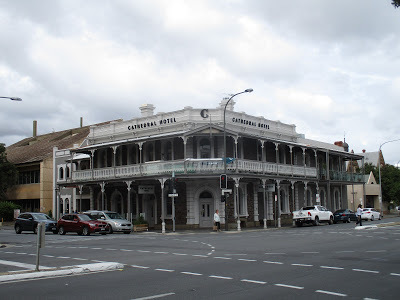 The Cathedral Hotel at North Adelaide
The Cathedral Hotel at North Adelaide
Photo: © 2017 Karen Tiller
Originally known as the Scotch Thistle Hotel in 1850, the hotel was established on the north side of Kermode Street and John Street (now King William Road), and in 1881, was moved to its present location. In 1925, the hotels name was changed to The Cathedral Hotel, and it has continued trading under this name for almost 100 years!
In 1918, several robberies had been occurred in and around North Adelaide. The police had no suspects, until a robbery occurred at the Scotch Thistle Hotel on October 4th. Mr Opie, husband of the hotels licensee, was on shift, and had closed the hotel. He followed his regular routine, locking all the doors and windows, except the one leading to the billiard room. He put the till into the store room, just off the dining room, turned out the lights, and locked the exit door on his way out at 2am.
The following morning, Dorothy Walloschick, Mrs Ethel Opie’s sister, opened the hotel. At 6:30am, she found the storeroom door unlocked and all the contents of the room strewn about the place and the kitchen and billiard room doors had been left open by the offender.
The burglar had smashed a window in the billiard room to gain entry, which he must’ve been very quiet in doing, as the Opie’s, asleep upstairs, did not wake to the sound.Only a couple of months previously, a store on O’Connell street owned by Mr LeCornu had several items stolen. It was reported that the front door had been left unlocked, and the investigating Constable, Mr George Wyatt, had returned the key to Mr LeCornu, and then filed a report for the missing goods.
The goods included garden hoses, barbered wire, tools, implements and paint.Missing from the Hotel were 10 bottles of Chateau Tanunda brandy, seven-pint bottles of Heather Bell whisky, three bottles of Walker's whisky, three bottles of Dewar's whiskey, two bottles of Burke's Irish whisky, eight-quart bottles of Henke's schnapps, eight bottles of Reynella family port, and twelve half flasks of-Heather Bell whisky, also missing, £22 in money.
Continued next week!
Researched and written Bibliography published in next edition.
 The Cathedral Hotel at North Adelaide
The Cathedral Hotel at North AdelaidePhoto: © 2017 Karen Tiller
Originally known as the Scotch Thistle Hotel in 1850, the hotel was established on the north side of Kermode Street and John Street (now King William Road), and in 1881, was moved to its present location. In 1925, the hotels name was changed to The Cathedral Hotel, and it has continued trading under this name for almost 100 years!
In 1918, several robberies had been occurred in and around North Adelaide. The police had no suspects, until a robbery occurred at the Scotch Thistle Hotel on October 4th. Mr Opie, husband of the hotels licensee, was on shift, and had closed the hotel. He followed his regular routine, locking all the doors and windows, except the one leading to the billiard room. He put the till into the store room, just off the dining room, turned out the lights, and locked the exit door on his way out at 2am.
The following morning, Dorothy Walloschick, Mrs Ethel Opie’s sister, opened the hotel. At 6:30am, she found the storeroom door unlocked and all the contents of the room strewn about the place and the kitchen and billiard room doors had been left open by the offender.
The burglar had smashed a window in the billiard room to gain entry, which he must’ve been very quiet in doing, as the Opie’s, asleep upstairs, did not wake to the sound.Only a couple of months previously, a store on O’Connell street owned by Mr LeCornu had several items stolen. It was reported that the front door had been left unlocked, and the investigating Constable, Mr George Wyatt, had returned the key to Mr LeCornu, and then filed a report for the missing goods.
The goods included garden hoses, barbered wire, tools, implements and paint.Missing from the Hotel were 10 bottles of Chateau Tanunda brandy, seven-pint bottles of Heather Bell whisky, three bottles of Walker's whisky, three bottles of Dewar's whiskey, two bottles of Burke's Irish whisky, eight-quart bottles of Henke's schnapps, eight bottles of Reynella family port, and twelve half flasks of-Heather Bell whisky, also missing, £22 in money.
Continued next week!
Researched and written Bibliography published in next edition.
Published on May 22, 2018 03:00
May 15, 2018
Haunted Art Gallery
Haunted Art Gallery
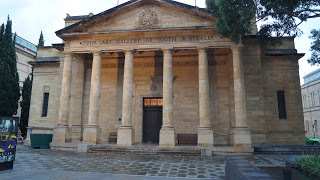 The Art Gallery of South Australia, North Terrace
The Art Gallery of South Australia, North TerracePhoto: © 2017 Allen Tiller
On May 13th, 2005, television show Stateline, on the ABC, broadcast an episode about an alleged haunting at the Art Gallery of South Australia. The story was reported by Patrick Emmett, the following is the transcript from the episode.Adelaide Art Gallery
Patrick Emmett: It was early one morning while he was checking the halls of the Art Gallery before opening that Trent had his first close encounter of a different kind.
Trent: I was almost in the door. It was pitch black, there was no lights on and, all of the sudden, there was this – this great burst of white light that went across the room, and it actually made me fully step back, I went “Oh, crikey, what was that?!?”
Patrick Emmett:Shaken, he checked what security cameras had picked up and what he saw surprised him even more. They showed him entering the room, reacting, but no sign of the mysterious light.
Trent: Its quite regular that you will see a frightened patron who wants to leave a particular area or a frightened staff member who has seen a ghost.
Patrick Emmett:Trent’s story is one of many you will hear from those who patrol the Art Gallery on North Terrace. There are tales of mysterious old ladies, pictures that move on their own and unexplainable spine-tingling drafts.
Female Witness:The cold comes through the floor, starts onto your legs and it goes up, and the actual hairs on your neck stand up, every hair on your body just is standing on end. As I came to this doorway I saw a flash of someone.
Patrick Emmett:The encounters can happen at anytime of the day. Staff report seeing strange people but when they search for them, they’ve disappeared!
Female Witness: I saw a dark shape go past the gallery archway and I thought “There shouldn’t be anybody down here” So I sped up a little bit, expecting to see somebody, and I entered gallery 19 and there was no-one there, and then I saw the same shape go past the archway of gallery 18. So, I came down a little bit quicker expecting to see who was here and I checked this whole gallery and there was no-one there. I looked up through the staircase to see if anybody was running up the stairs and there was no-one here.
Male Witness: I saw a lady in a long white dress of old period costume, high neckline and a bustle at the back. She had her hair in a bun and she just walked straight across the archway and I though, “Well, it’s a hot day, what are you doing wearing a dress like this on a day like”-you know, I remember it was a Tuesday and it was really hot, so I walked through just to have a quick look and I looked to me left and the lady wasn’t there. I though “this is really strange, she must have snuck into the other gallery without me seeing her”.I walked through into gallery 20 and the lady wasn’t there either and that’s when I started thinking” hang on, what have I seen here? “
Patrick Emmett:Many of the sightings are in what’s called the Morris Gallery. A mysterious old lady in a green dress often appears, sometimes sitting in a rocking chair. Staff rarely tell their tales to outsiders, so they were dumbfounded when approached by a recent visitor.
Female Witness: And he approached me, and he said, “There’s so much energy in this room, and there is a presence” and I said “Well, that’s interesting” I said, “Can you communicate with this presence?” and he said, “Yes I can”. So, I asked him to and he did, and he said to me “There’s a little lady that lives in the gallery and she loves it here, but she’s got one complaint and that is that the gallery, this particular gallery, is very cold”.
Patrick Emmett:While the old lady might be happy in the Morris Gallery not everyone is so relaxed about her residency. Some patrons have refused to enter the room because of its atmosphere, including two Japanese tourists.
Trent: They got down as far as gallery 20 and they started really getting scared and they said, “Can you please get us out of this gallery as quickly as possible” and we got them to the stairs just here and as soon as we got them to the stairs, they ran up the stairs.
Patrick Emmett: Another visitor has warned staff that this painting is evil and the source of the unrest. It’s not clear what is the background is, but one worker believes he’s seen this woman walking the halls.
But there are strange happenings in other galleries as well. There was the green glow in a recent Egyptian exhibition, and books and chairs sliding around by themselves and then there was the day the two guards opened these rarely used doors that look into a car park.
Male Witness: The opened them and this particular guy, he said “Did you see?” and he didn’t even get that out and the other guy said “I never want to talk about this again. I saw nothing”. And apparently what they saw was just scrub and desert outside the doors when they opened them for a few seconds and then it went back to carpark.
Patrick Emmett:Some say the hauntings are because the gallery is built on an old grave site. Others say they’re because two people were once hanged inside the grounds, and there are the cynics that say they’re just the product of fertile imaginations, but the believers say they were once also cynics, but they can’t disbelieve the evidence of their own eyes.
Male Witness: I’m not into that sort of thing and, quite frankly, I didn’t believe anything like that existed, but you have to change your mind when you see things like this and they’re unexplained.
Female Witness: They’re here. They haven’t actually hurt anyone. They just live here as part of us. It’s part of the gallery, so we just don’t worry about them.Transcript: Haunted Art GalleryBroadcast: 13-05-2005Reporter: Patrick EmmettNetwork: ABCProgram: Stateline.
Transcribed by Allen Tiller
Published on May 15, 2018 03:00
May 8, 2018
Rundle Street Gun Shop Siege – 1976
Rundle Street Gun Shop Siege – 1976
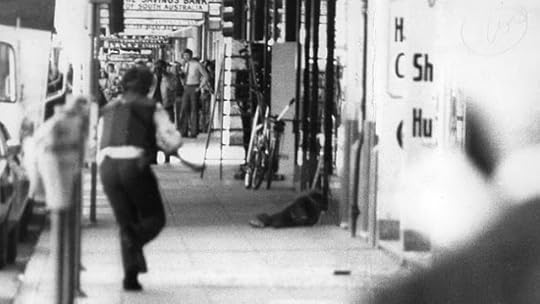
In mid-1974, Michael Hooke (sometimes known as Michael O’Conner) spent a few months in Royal Park Mental Hospital in Melbourne from December 10 to December 21, 1973, and then from January 9 until March 16, 1974.
Later that year, he decided that for his life to improve he needed to move to Adelaide, South Australia.
In 1976, just after 11am on May 10th, the 43 old O’Connor entered the Hambly-Clarke & Son Gun Shop at the eastern end of Rundle Street. He picked up two shotguns from the counter, and began to load them with his own ammunition.
O’Connor fired a shot inside the shop and ordered everyone to leave. The staff and customers got out through the front door, with shop owner, Mr Hambly Clark escaping through the back entrance.
The police arrived, the first response officer being unarmed officer, Constable G.P. Marr, who tried to reason with O’Connor, only to have two shots fired in his direction. The area was quickly cordoned off, and the Armed Offenders Apprehension Group (a predecessor the today’s STAR Force) arrived on scene.
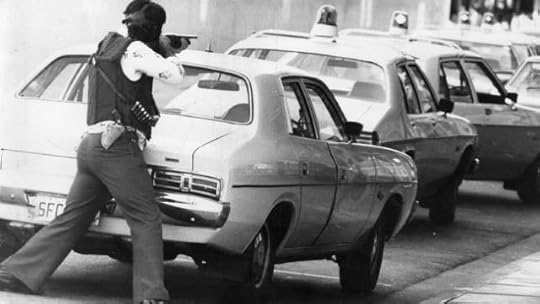
The Armed Offenders Apprehension Group fired tear gas into the shop to try and get O’Connor to leave. About 5 minutes later O’Connor emerged from the shop brandishing two shotguns.
He was ordered to drop the guns, but refused. Instead he fired off some random shots, then levelled his guns at near by police officers.
A loud crack rang out in Rundle Street, O’Connor felt hot steal penetrate his lower chest. Across the street in a furniture store window, sat Det. Sr. Const. Ramsden, SAPOL’s best marksman, who had just taken the order to shoot at will.
Police set upon O’Connor, and he was taken away to the Royal Adelaide Hospital in an ambulance, only to die a short time later from a haemorrhage in his upper stomach caused by the gunshot wound.No motive was ever put forward for the siege.
© 2018 Allen Tiller
Like us on Facebook: https://www.facebook.com/TheHauntsOfAdelaide/
www.allentiller.com.auwww.eidolonparanormal.com.au
Bibliography
1976 'MAN SHOT IN LONG SIEGE', The Canberra Times (ACT : 1926 - 1995), 11 May, p. 1. , viewed 05 Jan 2018, http://nla.gov.au/nla.news-article131816642
Robertson D, 2014, Adelaide has witnessed several violent incidents that stopped the city before Rodney Clavell’s siege, The Advertiser, viewed 5 Jan 2018, http://www.adelaidenow.com.au/news/south-australia/adelaide-has-witnessed-several-violent-incidents-that-stopped-the-city-before-rodney-clavells-siege/news-story/2b7d526fadcc034e3b4a67938e4fff10
1976 'Police justified in firing. coroner says', The Canberra Times (ACT : 1926 - 1995), 28 July, p. 12. , viewed 06 Jan 2018, http://nla.gov.au/nla.news-article110819250
Sadler, R. K. (Rex Kevin) & Hayllar, T. A. S. (Thomas Albert S.) & Powell, C. J. (Clifford J.) 1990, Enjoying English. Book 3, Macmillan, South Melbourne

In mid-1974, Michael Hooke (sometimes known as Michael O’Conner) spent a few months in Royal Park Mental Hospital in Melbourne from December 10 to December 21, 1973, and then from January 9 until March 16, 1974.
Later that year, he decided that for his life to improve he needed to move to Adelaide, South Australia.
In 1976, just after 11am on May 10th, the 43 old O’Connor entered the Hambly-Clarke & Son Gun Shop at the eastern end of Rundle Street. He picked up two shotguns from the counter, and began to load them with his own ammunition.
O’Connor fired a shot inside the shop and ordered everyone to leave. The staff and customers got out through the front door, with shop owner, Mr Hambly Clark escaping through the back entrance.
The police arrived, the first response officer being unarmed officer, Constable G.P. Marr, who tried to reason with O’Connor, only to have two shots fired in his direction. The area was quickly cordoned off, and the Armed Offenders Apprehension Group (a predecessor the today’s STAR Force) arrived on scene.

The Armed Offenders Apprehension Group fired tear gas into the shop to try and get O’Connor to leave. About 5 minutes later O’Connor emerged from the shop brandishing two shotguns.
He was ordered to drop the guns, but refused. Instead he fired off some random shots, then levelled his guns at near by police officers.
A loud crack rang out in Rundle Street, O’Connor felt hot steal penetrate his lower chest. Across the street in a furniture store window, sat Det. Sr. Const. Ramsden, SAPOL’s best marksman, who had just taken the order to shoot at will.
Police set upon O’Connor, and he was taken away to the Royal Adelaide Hospital in an ambulance, only to die a short time later from a haemorrhage in his upper stomach caused by the gunshot wound.No motive was ever put forward for the siege.
© 2018 Allen Tiller
Like us on Facebook: https://www.facebook.com/TheHauntsOfAdelaide/
www.allentiller.com.auwww.eidolonparanormal.com.au
Bibliography
1976 'MAN SHOT IN LONG SIEGE', The Canberra Times (ACT : 1926 - 1995), 11 May, p. 1. , viewed 05 Jan 2018, http://nla.gov.au/nla.news-article131816642
Robertson D, 2014, Adelaide has witnessed several violent incidents that stopped the city before Rodney Clavell’s siege, The Advertiser, viewed 5 Jan 2018, http://www.adelaidenow.com.au/news/south-australia/adelaide-has-witnessed-several-violent-incidents-that-stopped-the-city-before-rodney-clavells-siege/news-story/2b7d526fadcc034e3b4a67938e4fff10
1976 'Police justified in firing. coroner says', The Canberra Times (ACT : 1926 - 1995), 28 July, p. 12. , viewed 06 Jan 2018, http://nla.gov.au/nla.news-article110819250
Sadler, R. K. (Rex Kevin) & Hayllar, T. A. S. (Thomas Albert S.) & Powell, C. J. (Clifford J.) 1990, Enjoying English. Book 3, Macmillan, South Melbourne
Published on May 08, 2018 03:00
May 1, 2018
Haunted Adelaide: Adelaide Oval Scoreboard
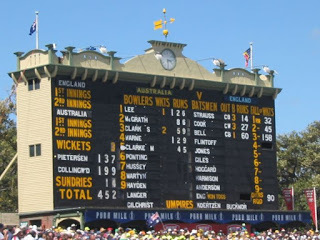 Haunted Adelaide: Adelaide Oval Scoreboard
Haunted Adelaide: Adelaide Oval ScoreboardThere have long been rumours that the old Adelaide Oval Scoreboard is haunted but no-one can identify the mysterious figure alleged to been witnessed in the old building.
It would seem the first-hand experiences of this ghost are few and far between, with only a handful of anecdotes about sightings of this mysterious spirit surfacing in the last 100 years.
Could it be instead, that the haunting of the Old Scoreboard is an urban legend, made up to rationalise a supporter’s feeling as to why their team is losing, or lost the game? “It must’ve been the ghost in the scoreboard that got the scores wrong!”
The identity of the alleged ghost, whether real or urban legend, remains a mystery…
History:The first Scoreboard at the Adelaide Oval was a manually operated, ‘hook’ style scoreboard used from 1879 until 1885, when a newer version was installed. This was followed by another upgrade in 1898.Designed by Kenneth Milne, The Adelaide Oval Scoreboard began being to be used in 1911, with a clock added in 1913, and later, in 1930, a windvane added to complete its look. The Adelaide Oval has been described as “one of the most picturesque Test Cricket grounds in Australia, if not the world.”
the oval was established in 1871 after the formation of the South Australian Cricket Association. The first Australian Rules Football game took place on the oval in 1877, between the Adelaide Football Club and the Bankers (football club) as part of the South Australian Football Association, later to be known as the SANFL.
researched and written by Allen Tiller © 2016.www.allentiller.com.auwww.eidolonpara...
Bibliography:
"Adelaide Oval" (Updated 10/11/2010) Austadiums.com, 10 November 2010. Retrieved 19 May 2014http://www.adelaidenow.com.au/bernard-humphreys-why-the-old-adelaide-oval-scoreboard-should-get-the-axe/news-story/a1e4ec44833d4577ee82551b8ed139e3
http://theconversation.com/not-just-cricket-protecting-heritage-at-the-adelaide-oval-21313https://scoreboardpressure.com/2011/10/28/adelaide-oval-south-australia/
http://adelaidepedia.com.au/wiki/Adel...
Published on May 01, 2018 03:00



